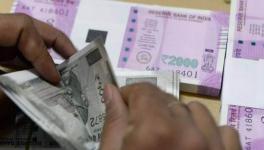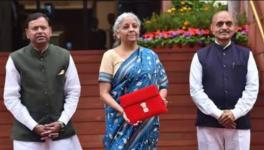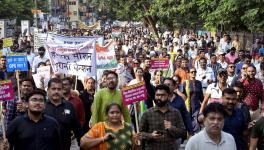Is India Losing the Battle Against COVID-19?
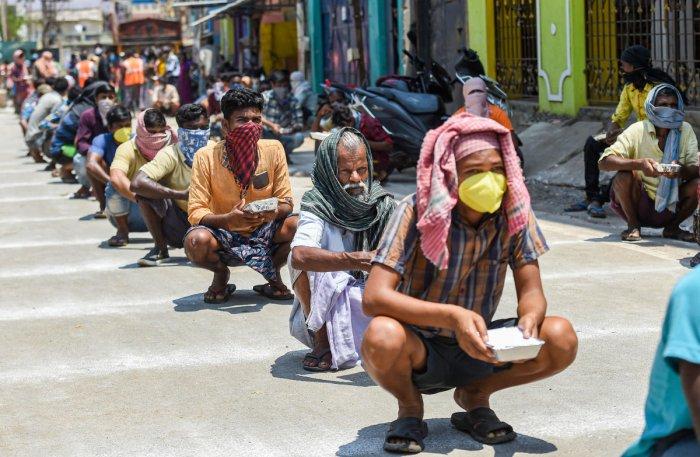
Workers waiting for food, Photo by PTI
The media narrative around India’s handling of the COVID-19 pandemic has been positive. A largely servile media has projected that the Modi government took the bold decision of announcing a national lockdown fairly early in the spread of the pandemic, which will spare India the fate of the US and many European countries which are seen the world over as having lost the fight in containing the spread of COVID-19. Modi, himself, has been projected as the knight in shining armour, leading this heroic battle with his bold decisions and periodic calls to raise the morale of the country, using utensil-banging and candle-lighting exercises which has seen the people’s enthusiastic participation.
However, are things really as rosy as the media has been projecting and what the people, by and large, believe? There is some indication that this is not the case. News reports claim that the Government is now considering extending the lockdown at the request of Chief Ministers and experts. Also, while the Government, till a few days ago, was categorical in stating that there was no community transmission (Phase 3) of the pandemic and we were still in Phase 2, in the last few days the Government has started talking about “limited cluster transmission”.
Clearly, earlier projections that all will be well after the 21-day lockdown, are not panning out. There has been a concerted effort by the media and even the Joint Secretary of the Ministry of Health, not to mention the BJP IT cell, in trying to communalise the pandemic by suggesting that the Tablighi Jamaat event has been single-handedly responsible for us losing control over the pandemic. In a press conference, Agarwal said that India’s COVID-19 cases were doubling every 4.1 days and that without the Jamaat event the doubling rate would be 7.4 days. This is a blatant lie. According to the ministry’s own numbers shared at the press conference, India went from 62 cases on March 10 to 4067 cases on April 6, which works out to a doubling rate of 4.14 days. And out of these, 1445 cases were linked to the Tablighi Jamaat. So, without Tablighi Jamaat, there would be 2622 cases which works out to a doubling rate of 4.63 days. Clearly, a nervous government is seeking to shift the blame towards the Jamaat and the Muslim community in general, to avoid accountability.
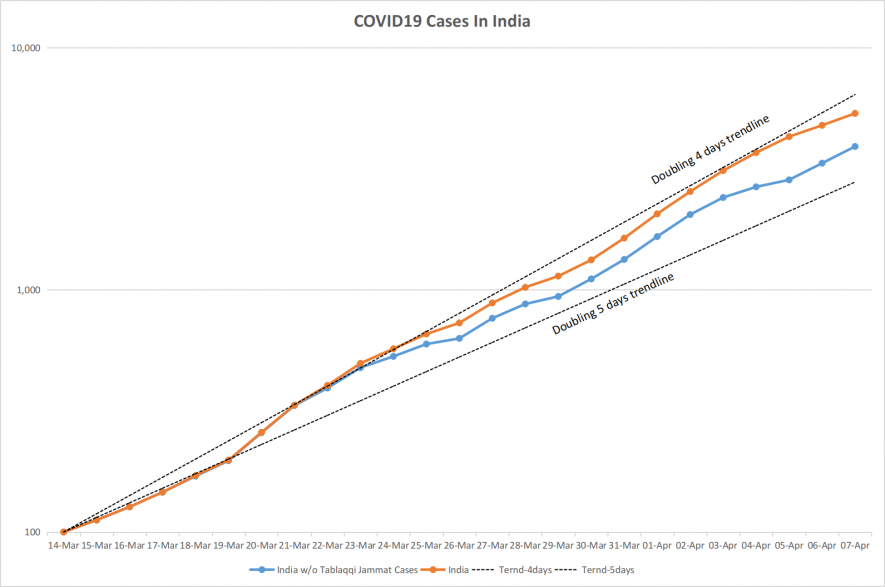
But, what do the actual numbers say? Going by the confirmed cases of COVID-19 in the country, we are doubling every 4 days. While that is still exponential growth, the numbers seem to suggest that we are not mirroring growth rates seen in the US and European countries where the pandemic is out of control and cases are doubling every 3 days. During exponential growth, the difference of that one day makes a huge dent in the final tally. If we begin at a doubling rate of three days with the 62 cases on March 10, we would be at 25184 cases by now.
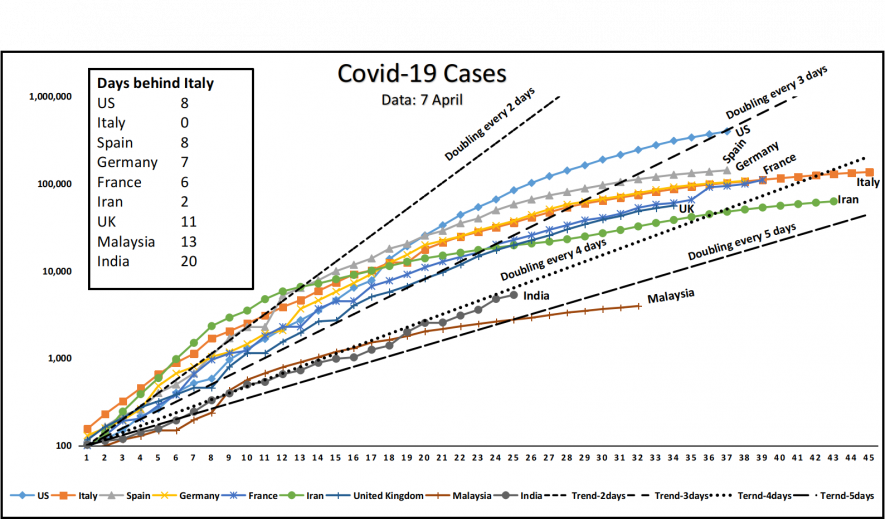
But, can we really trust the number of confirmed cases? India has one of the lowest COVID-19 testing rates in the world as the chart below shows.
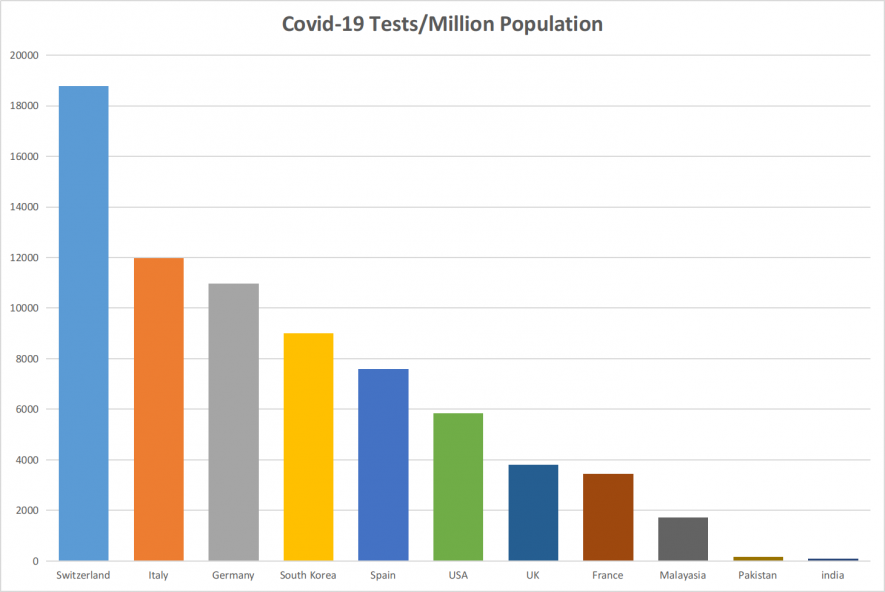
Another set of numbers may throw light on the real picture. A statistic that epidemiologists have been using is not the current confirmed cases but the number of reported deaths. The rationale behind this is that it will provide a more accurate picture than confirmed cases, a number which depends on how extensive the testing has been.
As of April 6, India reported 133 due to COVID-19; the country’s first death was reported on March 12 and the tenth death was reported on March 24. If one were to calculate by compounding rates from either of those two dates till date, we get an average rate of increase of daily deaths at 23%, which works out to a doubling rate of once every 3.4 days. The number is mid-way between the four-day doubling rate the case numbers suggest, and the three-day doubling rate of European countries where the pandemic has exploded.
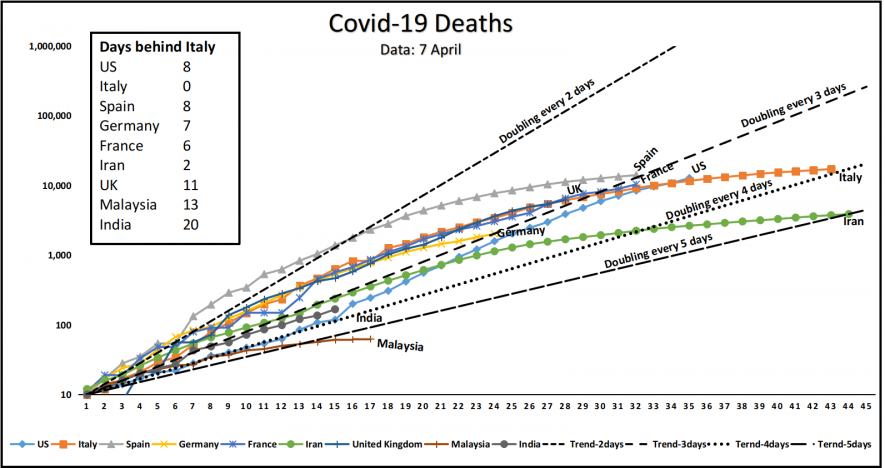
Another way to look at the numbers is to calculate the ratio of deaths against the resolved cases. Cases get resolved when either the person dies or has been declared “recovered”. As of April 6, the MoHFW declared that 382 people have recovered and 133 had died. So, deaths account for 26% of the resolved cases. How does this number compare with other countries?
If we look at the countries which are being held up as the success stories by WHO and the international community – South Korea is at 2.78% (deaths/resolved cases), China at 4.14%, Germany is at 4.78% and Iceland comes in with 1.27% – the deaths to resolved cases are clearly much lower. These countries have done extensive testing and also took decisive steps such as quarantines and lockdowns in order to control the pandemic. In this category, Malaysia is a surprising case. The country’s ratio is at 4.75%, showing that they too have the pandemic under control and have managed to “bend the curve”. Malaysia’s case is noteworthy since they had a Jamaat super-spreading event as well, but extensive testing and decisive steps have resulted in getting the pandemic under control. Such super-spreader events have occurred in every country, including South Korea, and it clearly cannot be an excuse to hide government failure.
However, if we look at the basket cases, they present a very different picture. The deaths to resolved cases ratios for the US (36%), Italy (42%), France (34%), Spain (25%) and the UK (an astonishing 97.5%) show that the pandemic is out of control. These countries began testing very late and were late to impose lockdowns and quarantine measures. Now, despite ramped-up measures and testing, the latter is not able to keep up with the exponential growth of the pandemic and hence the countries are not able to catch all the recovered cases who never got tested, while deaths with COVID-19 symptoms are counted as COVID19 deaths. Also, their health-care system has collapsed, unable to keep up with the stream of people needing hospitalisation, resulting in more than usual death rates.
But, has India reached this stage yet? Probably not, inspite of the high ratio of deaths to resolved cases at 26%. Our absolute number of deaths is still low and one has to wait for some more time before drawing definitive conclusions. Also, we are yet to see images of collapsing or overflowing hospitals. However, what the high ratio is indicative of is that we are severely under-testing and the pandemic is brewing in the population. We are probably behind the European countries by a couple of weeks.
Another data point to consider is that the ratio of positive results to total tests conducted is very low for India at 4.5%. This number is well below the countries where the pandemic is out of control. India’s testing has being very limited and targeted entirely at testing foreign travellers showing symptoms, and those who came in contact with them. The low ratio shows that the pandemic has been contained among these people at least. But, there is now enough evidence to suggest that the pandemic has spread beyond this group.
A report by the Medical Education and Drugs Department of Maharashtra shows that in the last week, many more non-travellers from the state are testing positive for COVID-19 than travellers. Our current national contact tracing-based testing strategy would clearly not be able to catch these increasing cases of community spread. So, we need to expand our testing to now start testing both people showing symptoms without any contact with travellers and random people, in order to catch the infected cases.
One thing that has to be admitted is that the Government did institute a national lockdown fairly early in the cycle, when the reported cases and the death numbers were low. However, the lockdown got off to a disastrous start with lakhs of migrant workers panicking and rushing back home, as no relief measures were announced for these out-of-job workers along with or preceding the lockdown announcement.
Also, since then, the lockdown has been leaking as evidenced by scores of people still visiting temples, markets, food kitchens and even taking out rallies to “celebrate” Modi’s shambolic calls for showing solidarity. Still, it cannot be denied that the lockdown has had some effect in reducing contact between people and probably in slowing down the still exponential growth curves. However, we seemed to have missed the opportunity to conduct extensive testing during this period. So, the Modi government now faces a Catch-22 situation. If the government lifts the lockdown on April 14, we are certain to face an pandemic explosion, while if they extend the lockdown then the economy, already reeling under a severe shock, is all set to worsen and lead to a full-fledged depression. Besides, in absence of a comprehensive strategy of extensive testing, the lockdown will, by itself, not stop the pandemic as the Modi government had initially hoped.
As the WHO has being repeatedly saying to anyone willing to listen in the last few months, there is really no alternative to “testing, testing, testing.” The government would do well to take this advice on war footing and also explore and introduce the rapid antibody-based blood tests which give quick results and can be used to scale-up testing rapidly. Even now, we are only testing about 10,000 people per day. For a country of 1.3 billion, we should have already been testing at least a lakh people per day. We need to reach that target as soon as early next week, and then look to scale it up even further, if we want to have any hope of containing the pandemic.
We are almost out of time!
Get the latest reports & analysis with people's perspective on Protests, movements & deep analytical videos, discussions of the current affairs in your Telegram app. Subscribe to NewsClick's Telegram channel & get Real-Time updates on stories, as they get published on our website.











